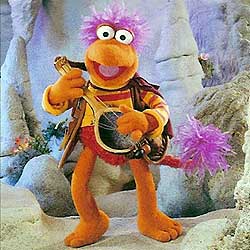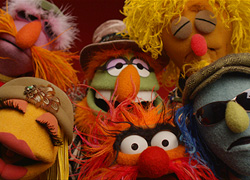Chad Kermit
Well-Known Member
- Joined
- Apr 19, 2002
- Messages
- 104
- Reaction score
- 0
http://www.cnn.com/2003/SHOWBIZ/Music/10/02/wkd.little.shop.ap/index.html
Meaner, toothier plant wants human food
Audrey II still star of 'Little Shop'
Thursday, October 2, 2003 Posted: 9:49 AM EDT (1349 GMT)
Martin P. Robinson and Michael-Leon Wooley pose with versions of Audrey II from "Little Shop of Horrors."
NEW YORK (AP) -- An hour before the curtain rose on a recent preview performance of "Little Shop of Horrors," pockets of quiet activity percolated on and around the stage of Broadway's Virginia Theatre.
A worker sluggishly pushed a mop bucket across Mushnik's infamous flower shop. Another man sat with legs dangling from the stage, muttering instructions into a walkie-talkie. Spotlights scanned the set's urban backdrop, while scales played by an unseen flutist rose from the orchestra pit.
In the middle of it all, sat a 7-foot, 3,000-pound colossus -- inanimate, waiting. The show's biggest star, a giant man-eating plant named Audrey II, is hard to miss.
She is the creation of Martin P. Robinson, a veteran of the Jim Henson Company and "Sesame Street." Robinson also designed the plant used in the original off-Broadway musical, which ran for more than 2,200 performances at the Orpheum Theatre in the 1980s. Each night, Robinson and three other puppeteers breathe life into the behemoth, aided by the booming, soulful voice of Michael-Leon Wooley.
The most recent incarnation of Audrey (there are four versions at various stages of development that appear in the show) is much the same as the original, Robinson said. But it has vegetated in subtle ways since the '80s.
"We had to make sure it read to a bigger house. It's darker, more detailed, more realistic, a little less cartoony," he said of the massive puppet. "Toothier. Meaner."
The show's producers have done their best to keep the largest version of Audrey under wraps so as not to spoil the effect for audiences.
The full-grown plant, which takes up much of the stage during the show's final scenes, germinated as an 11-inch clay model sculpted by Robinson. "We did a digital scan of it, fed it into computers and then fed the numbers through a huge milling machine," he said. It was milled out of foam and cast in Kevlar -- the light, resilient material used in bulletproof vests.
"Then welders came in and laid the welding all over her," he added.
Besides enhancements to its florid exterior, Audrey is more mobile than it was during its first New York run. "Mostly, what's different now is how she moves in space," Robinson pointed out. The pod is attached to an immense boom arm that is "literally a ton, ton-and-a-half of steel -- designed to lift her and move her safely and efficiently," he said.
'We're throwing ourselves around in there'
"Feed me, Seymour!": Audrey II lays down the law to the nebbishy Seymour (Hunter Foster).
Even with the help of the boom, though, animating Audrey is not easy.
"We basically wear body armor because we're throwing ourselves around in there," said Robinson, who alternates time inside the pod with Anthony Asbury, Bill Remington and Matt Vogel. At times, all four men operate the puppet in concert -- one in the pod, two in its "killer branches" and one on the boom.
"It's a matter of counterbalance and inertia," Robinson explained. "It's balanced very nicely, but it's still about 3,000 pounds of inertia. If you want her to turn right, you have to smash your elbow into it and lean all of your weight in so she drops and rolls. It's the most strenuous thing that I or any of the performers have ever done." And it must be done, of course, in seamless synchronization with Wooley's voice.
"If you want to get the thing going, you have to anticipate everything Michael says," Robinson said. "We actually have to be doing the move before he speaks."
During the show, Wooley is stationed in front of three video monitors and a soundboard. "I also have my script in front of me," Wooley said. "I have all my lines memorized, but it helps to follow along to make sure I know what everyone else is saying on stage."
Wooley expressed respect for his counterparts in Audrey's vivification.
"I noticed you all have more gear on every time I see you," he said to Robinson, as they sat in two of the Virginia's 1,275 seats. "They used to just have these shin guards. Now they look like X-Men."
"Because we're getting beat up. She took a bite out of me last night," Robinson responded. "My big shin guard rotated. ... The thing just chewed right into my leg."
The puppeteers' suits of armor were born out of necessity. "Before we got the shin guards we were just busted up and bruised," Robinson said.
The art of puppetry
Puppeteering became Robinson's passion after he developed a background in acting and sculpture. "Puppetry is the perfect synthesis of the two," he said.
Audrey is not the only puppet on Broadway. They populate the stage in the long-running musical "The Lion King" and the smash hit "Avenue Q," which recently transferred from off-Broadway.
Robinson, a longtime friend and "Sesame Street" colleague of several "Avenue Q" cast members, said he hopes the shows will change the way people think of puppetry.
It's the most strenuous thing that I or any of the performers have ever done.
-- Martin P. Robinson on operating Audrey II
"It's been something I've been trying to do most of my career -- getting puppets accepted as an actual art form," he said.
"This country has a strong tendency to think of puppetry as small art or kid show stuff," he said. "In Europe, it's been accepted as a major art form for hundreds and hundreds of years."
The craft appealed to him initially, he said, as a way to do theater, while remaining surreptitious. "As a human actor, I wasn't that interested in a 6-foot-2, rather affable guy," Robinson said, referring to himself. "I consider myself dull compared to the characters I play. Puppetry allows you to be anything -- male, female, animal, vegetable, mineral."
Wooley, 36, approached theater from the opposite direction.
"I started as a piano player," the 6-foot, 5-inch singer said in a warm, deep growl, "playing in the pits for some shows in community theater."
It was a thirst for the spotlight that led him to change his direction. "I decided I wanted to be up there," he said, pointing to the stage, "rather than down in the dark hole."
Ironically, "Little Shop" is the first show in which Wooley has performed a non-visible role. "Usually, I'm out dancing and singing and jumping around and hollering on stage," he said with a smile as big as his voice.
Wooley, who originally wanted to be a concert pianist, is a native of Bowie, Maryland. "Actually, Bowie has two claims to fame -- me and Kathie Lee Gifford," he pointed out.
As a singer, he has worked in opera, jazz and R&B. "You know, you have to sing a little bit of everything to be in show business," he said. "This is my fifth Broadway show."
Robinson, who apparently hadn't realized his cast mate's Broadway track record, let out an enthusiastic, "Wwwow! That's so cool."
"But this is the biggest and, I think, the best role I've had," Wooley said. "It's a coming out party for me in a lot of ways."
Making it to Broadway
The cast boasts a number of big names from recent Broadway hits -- Hunter Foster ("Unrinetown") as Seymour, Kerry Butler ("Hairspray") as Audrey (the character for whom the plant is named), Rob Bartlett ("Chicago") as Mushnik and Douglas Sills ("The Scarlet Pimpernel") as Orin, among other characters.
Robinson, who has won Emmy Awards for his work on "Sesame Street," including one for his performance as the ever-popular Snuffleupagus, is making his Broadway debut.
"When I graduated from high school in 1972, my high school drama teachers said, 'When you open on Broadway, we want to be there,' " recalled Robinson, a native of Milwaukee.
He hadn't talked to his former mentors since then, but recently got in touch through the Internet. Both of his former teachers will be at the Virginia when the show opens Thursday night. "They're flying in," he said, "one from Dodge City, Kansas, and one from Sauk City, Wisconsin."
Also attending the opening will be Mel Welles, who played Mushnik, the flower shop owner, in the original 1960 Roger Corman film upon which the musical is based. The low-budget movie, which featured Jack Nicholson, is a cult classic. Robinson described it as "inspired genius."
There was also the popular 1986 musical film directed by Frank Oz and starring Rick Moranis as Seymour. That version was closely based on the off-Broadway musical, but like most film adaptations, the story had a few twists.
Qualifying his affection for that movie, Robinson said, "Except for the ending, I loved it."
"My exact same feeling," Wooley concurred.
Meaner, toothier plant wants human food
Audrey II still star of 'Little Shop'
Thursday, October 2, 2003 Posted: 9:49 AM EDT (1349 GMT)
Martin P. Robinson and Michael-Leon Wooley pose with versions of Audrey II from "Little Shop of Horrors."
NEW YORK (AP) -- An hour before the curtain rose on a recent preview performance of "Little Shop of Horrors," pockets of quiet activity percolated on and around the stage of Broadway's Virginia Theatre.
A worker sluggishly pushed a mop bucket across Mushnik's infamous flower shop. Another man sat with legs dangling from the stage, muttering instructions into a walkie-talkie. Spotlights scanned the set's urban backdrop, while scales played by an unseen flutist rose from the orchestra pit.
In the middle of it all, sat a 7-foot, 3,000-pound colossus -- inanimate, waiting. The show's biggest star, a giant man-eating plant named Audrey II, is hard to miss.
She is the creation of Martin P. Robinson, a veteran of the Jim Henson Company and "Sesame Street." Robinson also designed the plant used in the original off-Broadway musical, which ran for more than 2,200 performances at the Orpheum Theatre in the 1980s. Each night, Robinson and three other puppeteers breathe life into the behemoth, aided by the booming, soulful voice of Michael-Leon Wooley.
The most recent incarnation of Audrey (there are four versions at various stages of development that appear in the show) is much the same as the original, Robinson said. But it has vegetated in subtle ways since the '80s.
"We had to make sure it read to a bigger house. It's darker, more detailed, more realistic, a little less cartoony," he said of the massive puppet. "Toothier. Meaner."
The show's producers have done their best to keep the largest version of Audrey under wraps so as not to spoil the effect for audiences.
The full-grown plant, which takes up much of the stage during the show's final scenes, germinated as an 11-inch clay model sculpted by Robinson. "We did a digital scan of it, fed it into computers and then fed the numbers through a huge milling machine," he said. It was milled out of foam and cast in Kevlar -- the light, resilient material used in bulletproof vests.
"Then welders came in and laid the welding all over her," he added.
Besides enhancements to its florid exterior, Audrey is more mobile than it was during its first New York run. "Mostly, what's different now is how she moves in space," Robinson pointed out. The pod is attached to an immense boom arm that is "literally a ton, ton-and-a-half of steel -- designed to lift her and move her safely and efficiently," he said.
'We're throwing ourselves around in there'
"Feed me, Seymour!": Audrey II lays down the law to the nebbishy Seymour (Hunter Foster).
Even with the help of the boom, though, animating Audrey is not easy.
"We basically wear body armor because we're throwing ourselves around in there," said Robinson, who alternates time inside the pod with Anthony Asbury, Bill Remington and Matt Vogel. At times, all four men operate the puppet in concert -- one in the pod, two in its "killer branches" and one on the boom.
"It's a matter of counterbalance and inertia," Robinson explained. "It's balanced very nicely, but it's still about 3,000 pounds of inertia. If you want her to turn right, you have to smash your elbow into it and lean all of your weight in so she drops and rolls. It's the most strenuous thing that I or any of the performers have ever done." And it must be done, of course, in seamless synchronization with Wooley's voice.
"If you want to get the thing going, you have to anticipate everything Michael says," Robinson said. "We actually have to be doing the move before he speaks."
During the show, Wooley is stationed in front of three video monitors and a soundboard. "I also have my script in front of me," Wooley said. "I have all my lines memorized, but it helps to follow along to make sure I know what everyone else is saying on stage."
Wooley expressed respect for his counterparts in Audrey's vivification.
"I noticed you all have more gear on every time I see you," he said to Robinson, as they sat in two of the Virginia's 1,275 seats. "They used to just have these shin guards. Now they look like X-Men."
"Because we're getting beat up. She took a bite out of me last night," Robinson responded. "My big shin guard rotated. ... The thing just chewed right into my leg."
The puppeteers' suits of armor were born out of necessity. "Before we got the shin guards we were just busted up and bruised," Robinson said.
The art of puppetry
Puppeteering became Robinson's passion after he developed a background in acting and sculpture. "Puppetry is the perfect synthesis of the two," he said.
Audrey is not the only puppet on Broadway. They populate the stage in the long-running musical "The Lion King" and the smash hit "Avenue Q," which recently transferred from off-Broadway.
Robinson, a longtime friend and "Sesame Street" colleague of several "Avenue Q" cast members, said he hopes the shows will change the way people think of puppetry.
It's the most strenuous thing that I or any of the performers have ever done.
-- Martin P. Robinson on operating Audrey II
"It's been something I've been trying to do most of my career -- getting puppets accepted as an actual art form," he said.
"This country has a strong tendency to think of puppetry as small art or kid show stuff," he said. "In Europe, it's been accepted as a major art form for hundreds and hundreds of years."
The craft appealed to him initially, he said, as a way to do theater, while remaining surreptitious. "As a human actor, I wasn't that interested in a 6-foot-2, rather affable guy," Robinson said, referring to himself. "I consider myself dull compared to the characters I play. Puppetry allows you to be anything -- male, female, animal, vegetable, mineral."
Wooley, 36, approached theater from the opposite direction.
"I started as a piano player," the 6-foot, 5-inch singer said in a warm, deep growl, "playing in the pits for some shows in community theater."
It was a thirst for the spotlight that led him to change his direction. "I decided I wanted to be up there," he said, pointing to the stage, "rather than down in the dark hole."
Ironically, "Little Shop" is the first show in which Wooley has performed a non-visible role. "Usually, I'm out dancing and singing and jumping around and hollering on stage," he said with a smile as big as his voice.
Wooley, who originally wanted to be a concert pianist, is a native of Bowie, Maryland. "Actually, Bowie has two claims to fame -- me and Kathie Lee Gifford," he pointed out.
As a singer, he has worked in opera, jazz and R&B. "You know, you have to sing a little bit of everything to be in show business," he said. "This is my fifth Broadway show."
Robinson, who apparently hadn't realized his cast mate's Broadway track record, let out an enthusiastic, "Wwwow! That's so cool."
"But this is the biggest and, I think, the best role I've had," Wooley said. "It's a coming out party for me in a lot of ways."
Making it to Broadway
The cast boasts a number of big names from recent Broadway hits -- Hunter Foster ("Unrinetown") as Seymour, Kerry Butler ("Hairspray") as Audrey (the character for whom the plant is named), Rob Bartlett ("Chicago") as Mushnik and Douglas Sills ("The Scarlet Pimpernel") as Orin, among other characters.
Robinson, who has won Emmy Awards for his work on "Sesame Street," including one for his performance as the ever-popular Snuffleupagus, is making his Broadway debut.
"When I graduated from high school in 1972, my high school drama teachers said, 'When you open on Broadway, we want to be there,' " recalled Robinson, a native of Milwaukee.
He hadn't talked to his former mentors since then, but recently got in touch through the Internet. Both of his former teachers will be at the Virginia when the show opens Thursday night. "They're flying in," he said, "one from Dodge City, Kansas, and one from Sauk City, Wisconsin."
Also attending the opening will be Mel Welles, who played Mushnik, the flower shop owner, in the original 1960 Roger Corman film upon which the musical is based. The low-budget movie, which featured Jack Nicholson, is a cult classic. Robinson described it as "inspired genius."
There was also the popular 1986 musical film directed by Frank Oz and starring Rick Moranis as Seymour. That version was closely based on the off-Broadway musical, but like most film adaptations, the story had a few twists.
Qualifying his affection for that movie, Robinson said, "Except for the ending, I loved it."
"My exact same feeling," Wooley concurred.

 Welcome to the Muppet Central Forum!
Welcome to the Muppet Central Forum! Back to the Rock Season 2
Back to the Rock Season 2 Sesame Street Season 54
Sesame Street Season 54 The Muppets Mayhem premieres
The Muppets Mayhem premieres Bear arrives on Disney+
Bear arrives on Disney+ Sam and Friends Book
Sam and Friends Book